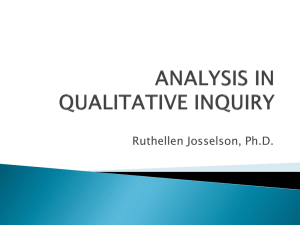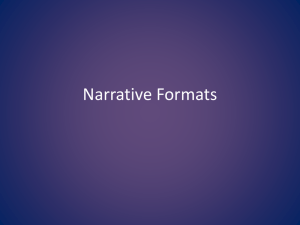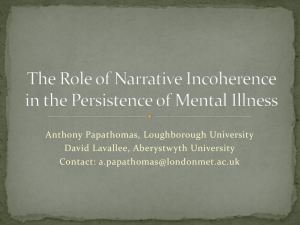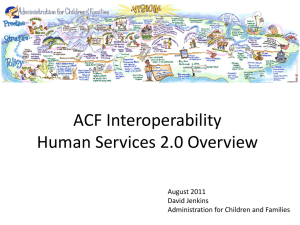Narrative Viewpoint and Voice
advertisement
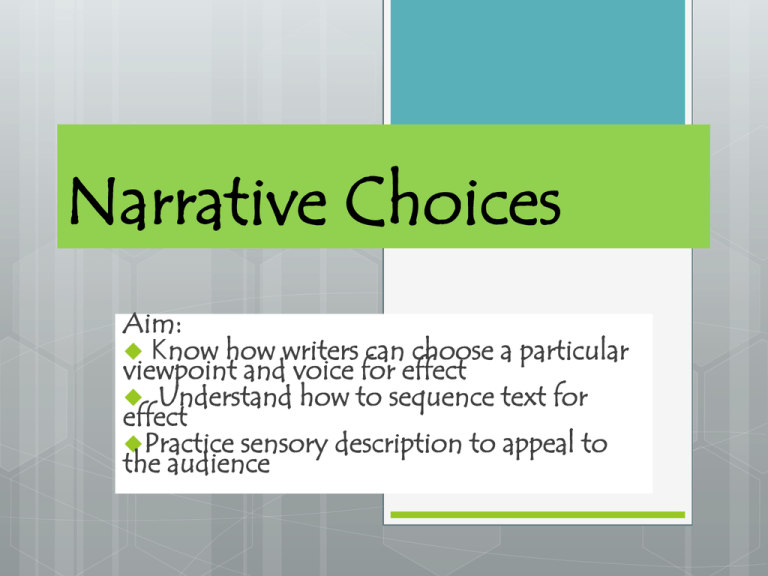
Narrative Choices Aim: Know how writers can choose a particular viewpoint and voice for effect Understand how to sequence text for effect Practice sensory description to appeal to the audience Task: 1. Imagine you are taking this photograph. Where are you? What can you see from this vantage point? Compose three sentences- using THIRD PERSON 2. Imagine you are the man in the picture, about to take a photograph. Describe what you can see from your vantage point. Compose three sentences- using FIRST PERSON SensoryTask: 1. You have been asked to recreate this picture with description. Think of at least two other senses you would appeal to. 2. You have just been momentarily blinded (something to do with the hamburglar, I guess) Describe the scene using just those two other senses. Compose three sentences- using FIRST PERSON Examples: Standing in the doorway, hands in pockets, he looked surprisingly relaxed. The storm raged around him but he hardly seemed to notice. A warm orange light spilled from one of the windows. I watched the helicopter whirl away, buffeted by the storm. My ears rushed with the roar of water. I felt alone and afraid: how would I survive? What are the differences between the two different viewpoints? Do their ‘voices’ sound the same or different? Which viewpoint is most effective for telling this story? Narrative Viewpoint and Voice When we read, we “see” images in our mind and “hear” a voice in our heads. Writers can choose whose “eyes” we see through and whose “voice” we hear telling the story. So, writers can choose…. First person narrative or third person narrative Past tense or present tense Writers can tell a story In the order in which events happen, through flashback to events that happened earlier, from one viewpoint or more than one Read the extracts (Private Peaceful and The Other Side of Truth) Resource 1 The Other Side of Truth Is it written in first or third person? Effect? Past or present tense? Effect? Whose eyes do we ‘see’ through? What does their ‘voice’ sound like? Private Peaceful Plenary Re-write a section from either extract. Change: First person into third person (or vice versa) Write from another viewpoint – Charlie perhaps or Mr Munnings How has it changed the tone of the writing? Lesson 2- Multiple Narratives Learning Objective: - Learn how using different narrative viewpoints can have different effects Starter: What does the term DUAL NARRITIVE mean? Discuss in pairs. Dual narrative: More than one person is telling the story. The different narrators might see the same event in different ways Drama - Get into groups of three - Each take a role - First form a freeze frame that conveys what is happening in the image - Then, one at a time, come out of your freeze frame and tell the audience your point of view You are the person in the picture. Tell us the story of how you came to be here. You work as an inspector for the RSPCA. Tell us what you found when you arrived at the scene and what you decided to do- how do you feel about the owner? You are the dog. Tell us about your life with your owner. Sorting task: Sort the cut up extract into the order you think is correct… Resource 2 NOW… Read the Jaws extract: - Was it similar or different to your version? - Discuss in pairs HOW tension is built up through the narrative structure (voice, dual narrative etc) Resource 3 Task 2: Choose another viewpoint e.g. the boy’s mother or father sunbathing on the beach or a Life guard witnessing the event. Write a short paragraph that can be fitted into the story to include their viewpoint. Use the third person e.g. The boy’s mother…..she…. The lifeguard….he…. Write in the past tense e.g. She glanced out to sea. Was that really him, so far from the shore? Decide where in the story your viewpoint would go? Could you include a flashback? Match these terms: Narrative voice - story told using ‘he’, ‘she’- not directly involved First person - moves back in time to tell about something that happened before Third person- story told using “I”- directly involved Flashbacks ‘eyes’ and ‘voice’ through which the story is told. - Narrative viewpoint- more than one person telling the story Dual narrative- how the speaker of the story sounds




